When it comes to traveling with our furry friends, their safety should always be a top priority. This is especially true when driving with your dog in the car. By following a few key safety tips, you can ensure your pet stays secure and protected throughout the journey.
First and foremost, I would advise that you plan ahead. Before hitting the road, make sure your dog is restrained in the back seat. This helps prevent distractions and keeps them away from potential hazards. The safest way for your dog to travel is either in a carrier or with a pet seatbelt, specifically designed to keep them secure.
If your dog is new to car rides, take short trips to get them accustomed to traveling in a car. This helps reduce anxiety and motion sickness that some dogs may experience. Additionally, it’s advisable to feed your pet a light meal before the journey to prevent car sickness and avoid feeding them in a moving vehicle.
Another vital aspect of dog car safety is to never leave your pet alone in a parked car. Temperatures inside a vehicle can rise rapidly, even with the windows cracked, which can be extremely dangerous for your dog’s health.
Finally, make sure to pack a travel kit with essential items such as food, water, leash, waste bags, and any medications your dog may need. Additionally, ensure your pet is properly identified with tags or a microchip in case they get lost during the journey.
Key Takeaways:
- Restrain your dog in the back seat to prevent distractions and potential hazards.
- Travel with your dog in a carrier or use a pet seatbelt for their safety.
- Acclimate your dog to car rides by starting with short trips and gradually increasing the duration.
- Feed your dog a light meal before traveling to prevent car sickness.
- Never leave your dog alone in a parked car.
The Importance of Pet Safety on the Road
When embarking on a road trip with your furry friend, ensuring their safety should be a top priority. Traveling with an unrestrained pet can be dangerous, leading to distracted driving and potential accidents. You might want to prioritize your pet’s safety by following pet car safety guidelines.
- Restrain your dog in the back seat: By using a pet car harness or seatbelt, you can prevent distractions and potential hazards caused by an unrestrained pet.
- Protect your pet and other passengers: Properly securing your dog in the car can not only prevent them from getting injured in case of an accident but also protect other passengers from any potential harm caused by a loose pet.
By restraining your dog in the back seat, you can ensure a safe and pleasant road trip experience for everyone.
“Traveling with a dog in the car without any restraint is not only dangerous but also irresponsible. It puts both the dog and the driver at risk. You should prioritize the safety of our pets on the road to prevent accidents and ensure their well-being.” – Pet Safety Expert
Table: Pet Car Safety Restraint Options
| Restraint Option | Description |
|---|---|
| Pet Car Harness | A harness that attaches to the car’s seatbelt, keeping the dog securely in place. |
| Pet Car Seatbelt | A seatbelt specifically designed for pets, allowing them to be safely restrained in the car. |
| Pet Car Seat | A specialized seat that provides comfort and safety for smaller breeds during car rides. |
| Pet Crate | A crate that can be secured in the car, providing a safe and comfortable space for larger dogs. |
Choosing the right restraint option for your pet will depend on their size, breed, and comfort level. I would recommend to select a method that suits your pet’s needs and provides maximum safety during road trips.
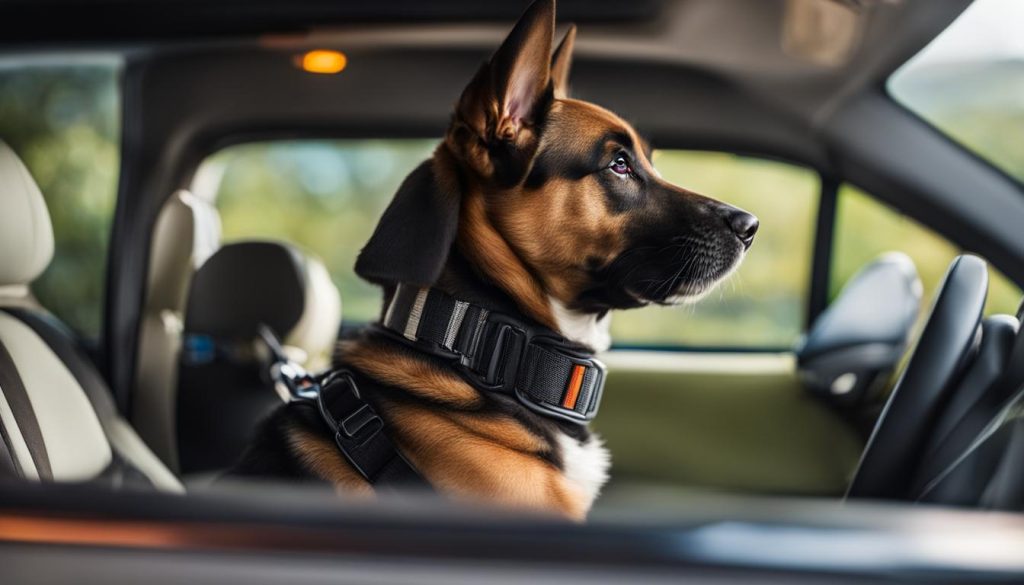
Preparing Your Dog for Safe Car Travel
Before embarking on a long journey with your canine companion, you should prepare them for car travel. By gradually introducing your dog to car rides and taking necessary precautions, you can help reduce anxiety and ensure a safe and comfortable journey for both of you.
To get your dog used to car rides, start with short trips around the neighborhood and gradually increase the duration. This will help them become familiar with the sensation of being in a moving vehicle. Additionally, consider using positive reinforcement techniques such as treats and praise to create positive associations with car travel.
Feeding your dog a light meal before the journey can help prevent car sickness. It is recommended to avoid feeding them in a moving vehicle to reduce the risk of nausea. However, make sure to provide fresh water and take regular breaks for bathroom breaks and exercise to keep your dog comfortable throughout the trip.
For dogs that experience anxiety during car travel, consider using calming aids such as a ThunderShirt or pheromone sprays to help them relax. Additionally, creating a cozy and secure space for your dog in the car, such as using a crate or a comfortable bed, can provide them with a sense of security and make them feel more at ease.
Table: Checklist for Preparing Your Dog for Car Travel
| Preparation Steps | Description |
|---|---|
| Gradual Introduction | Take short trips to help your dog become accustomed to car rides. |
| Positive Reinforcement | Use treats and praise to create positive associations with car travel. |
| Light Meal | Feed your dog a light meal before the journey to prevent car sickness. |
| Regular Breaks | Take frequent breaks for bathroom breaks and exercise. |
| Calming Aids | Consider using calming aids such as ThunderShirts or pheromone sprays for dogs with anxiety. |
| Cozy Space | Create a secure and comfortable space in the car with a crate or a cozy bed. |
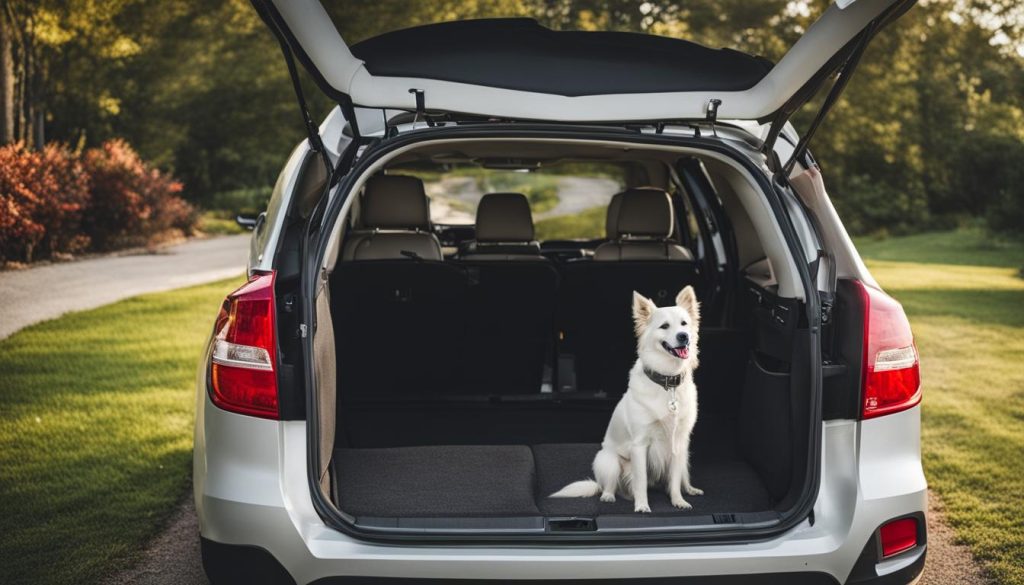
By following these guidelines, you can ensure that your dog is well-prepared for car travel and reduce the risk of discomfort or anxiety during the journey. Try to always prioritize your dog’s safety and well-being, and enjoy the adventure together!
Restraint Options for Traveling with Dogs
When it comes to traveling with dogs in the car, I would advise that you ensure their safety and prevent distractions. There are several options available for restraining your dog during car journeys, each with its own advantages and considerations.
1. Dog Car Harness
A dog car harness is a popular choice for many pet owners. It is designed to secure your dog in one position, preventing them from moving around the car and distracting the driver. A dog car harness typically attaches to the seatbelt system or the car’s latch bars. It provides comfort and safety, allowing your dog to sit, lie down, or stand comfortably during the journey.
2. Dog Seatbelt
A dog seatbelt is similar to a dog car harness but without the full-body coverage. It attaches directly to your dog’s collar or harness and clicks into the seatbelt buckle. This option provides some level of restraint, but it may not offer the same level of security as a dog car harness. I recommend that you choose a seatbelt that is suitable for your dog’s size and weight.
3. Dog Car Seats
For smaller dog breeds, a dog car seat can be a great option. These seats are designed to provide comfort and security while allowing your dog to have a higher vantage point. Dog car seats typically have a built-in harness or seatbelt attachment to keep your dog secure. They also help to prevent your dog from being thrown around in the event of sudden stops or accidents.
4. Dog Crate or Car Barrier
If you have a larger dog, a dog crate or car barrier can be used to keep them contained and secure during car travel. A dog crate should be large enough for your dog to comfortably stand, sit, lie down, and turn around. It should be properly secured to prevent it from shifting during the journey. A car barrier is another option for larger breeds, creating a barrier between the back seat and the rest of the car.
When choosing a restraint option for your dog, consider their size, breed, and comfort. I recommend that you follow the manufacturer’s instructions and ensure that the restraint is properly secured. To put it simply, restraining your dog in the car not only protects them but also helps to ensure your own safety and the safety of other passengers.

Potential Hazards for Dogs in Cars
When traveling with your dog in a car, be aware of the potential hazards that can arise. By understanding and mitigating these risks, you can ensure the safety and well-being of your furry companion. Here are some common hazards for dogs in cars:
- Dangers of letting dogs hang out the window: Allowing your dog to hang their head out the window may seem like a fun and exciting experience, but it can lead to serious injuries. Debris from the road can hit your dog, causing cuts, scratches, or even eye injuries. They can also be tempted to jump out of the window, putting them at risk of falling or getting hit by other vehicles.
- Risks of dogs riding in the front seat: While it may be tempting to let your dog ride shotgun, it can be extremely dangerous. In the event of an accident, an unrestrained dog in the front seat can be thrown forward with great force, potentially resulting in serious injuries or even death. It also increases the chances of the driver being distracted, leading to potential accidents.
I recommend that you keep your dog restrained in the back seat while traveling in a car to avoid these hazards. By using a dog car harness or seatbelt, you can ensure that your dog remains secure and protected. Additionally, avoiding any distractions caused by your dog, such as sticking their head out the window or riding in the front seat, can help maintain a safe environment for everyone in the car.
“Allowing dogs to hang out the window or ride in the front seat can pose significant risks. They can be struck by debris, thrown out of the window, or injured in the event of a collision.”
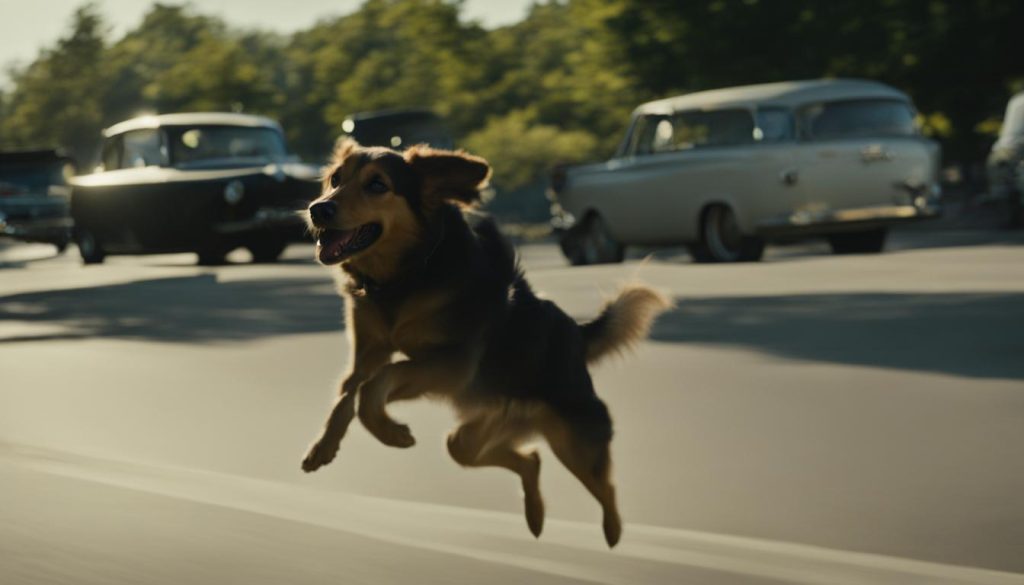
Summary:
When traveling with your dog in a car, please be mindful of potential hazards. Letting dogs hang out the window or ride in the front seat can expose them to the risk of injury or accidents. Keeping your dog restrained in the back seat with a proper harness or seatbelt is the safest option. By prioritizing their safety and eliminating distractions, you can provide a secure and comfortable journey for your furry friend.
Safety Tips for Traveling by Plane with Your Dog
When it comes to traveling with your dog, taking a trip by plane requires special considerations. Whether you’re embarking on a short domestic flight or a longer international journey, I would advise that you prioritize your pet’s safety and comfort. Here are some safety tips to ensure a smooth and stress-free experience for both you and your furry friend.
Traveling with Dogs in the Cabin
If your dog is small enough, some airlines allow them to travel in the cabin with you. This can provide peace of mind knowing that your pet is nearby and receiving the attention they need. However, check the airline’s specific requirements and restrictions for traveling with dogs in the cabin. Some airlines may have weight and carrier size limitations, while others may require additional documentation.
| Important Considerations for Traveling with Dogs in the Cabin |
|---|
| Ensure your dog’s carrier is airline-approved and meets the size requirements. |
| Make sure your dog is comfortable in their carrier and has enough space to stand, turn around, and lie down. |
| Bring essential items such as food, water, and familiar toys to keep your dog calm during the flight. |
| Follow the airline’s guidelines for check-in and boarding procedures with your pet. |
Health Certificate for Traveling with Dogs
Some airlines may require a health certificate issued by a veterinarian before allowing your dog to travel. This certificate confirms that your dog is in good health and up to date on vaccinations. I recommend that you schedule a visit to the vet well in advance of your travel date to ensure you have the necessary documentation. Additionally, if you’re traveling across state or international borders, you may need to comply with specific health and quarantine regulations.
Traveling by plane with your dog requires careful planning and preparation. By following these safety tips, you can help ensure a safe and pleasant journey for your furry companion. Try to check the airline’s policies, secure a health certificate if required, and provide your dog with a comfortable and secure carrier. With these precautions in place, you and your canine companion can enjoy your travels together.

Safety Tips for Traveling by Train with Your Dog
Traveling with dogs by train requires careful consideration of train pet policies and necessary documentation. Each train company may have different rules and regulations when it comes to traveling with pets. Therefore, it is essential to check the specific guidelines before embarking on your journey with your furry friend. By planning ahead and understanding the requirements, you can ensure a safe and hassle-free trip with your dog.
Train pet policies vary from company to company. Some train companies, like Amtrak, allow small dogs to travel in carriers. However, larger dogs may be restricted or require a separate ticket. I recommend that you verify the policies of the train company you plan to travel with to ensure that your dog is eligible and to avoid any surprises or complications on the day of travel.
In addition to train pet policies, documentation may also be required for traveling with dogs. Depending on the destination and the train company’s regulations, you may need to provide proof of vaccinations, health certificates, or other necessary documents. I highly suggest that you gather all the required paperwork and ensure that it is up to date before boarding the train with your dog.
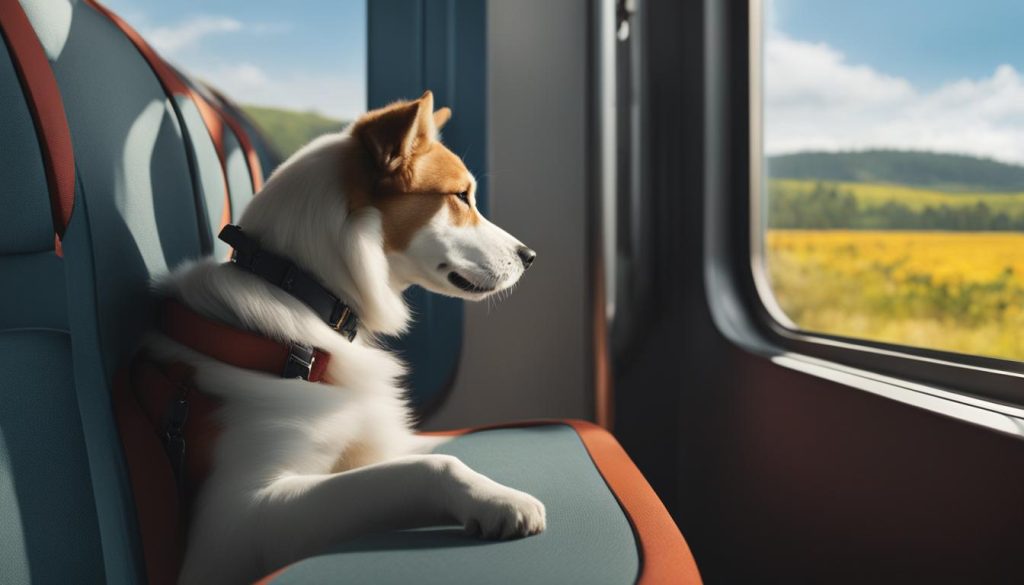
Safety Tips for Traveling by Boat with Your Dog
When it comes to traveling with your furry friend, taking a boat trip can be a unique and enjoyable experience for both of you. However, prioritize your dog’s safety during the journey. Here are some safety tips to consider when traveling by boat with your dog.
Pet-Friendly Cruise Lines
Before planning your boat trip, make sure to research pet-friendly cruise lines that allow dogs in the cabin. Not all cruise lines have the same policies when it comes to accommodating pets, so I would advise that you find one that suits your needs. Ensure that your pet will be allowed in the cabin with you, as some cruise lines may require pets to stay in onboard kennels or have restrictions on pet access to certain areas.
Restrictions on Pets in Cabins
Additionally, be aware of any restrictions or guidelines that may apply when bringing your dog into the cabin. Some cruise lines may have weight restrictions or breed restrictions for pets in the cabin. I recommend that you comply with these rules to ensure a safe and comfortable experience for both your dog and other passengers.
Traveling by boat with your dog can be a wonderful adventure, but please prioritize their safety and well-being. By selecting a pet-friendly cruise line and adhering to any restrictions or guidelines in place, you can ensure a smooth and enjoyable trip for you and your furry companion.
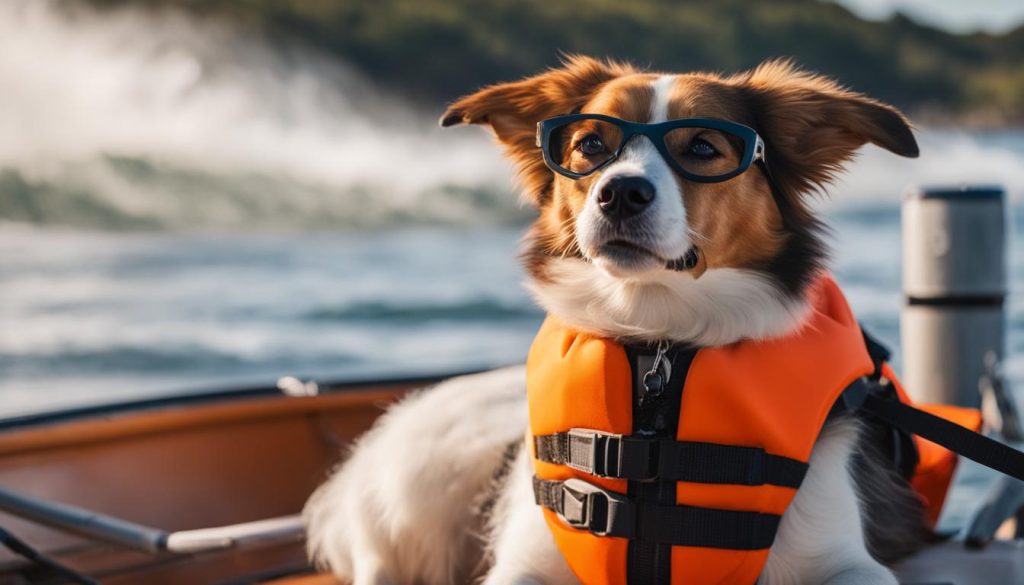
| Traveling by Boat with Your Dog: Safety Tips |
|---|
| Research pet-friendly cruise lines |
| Check if pets are allowed in the cabin |
| Be aware of any restrictions or guidelines |
Common Hazards for Dogs in Cars
Traveling in cars can pose various hazards for dogs. It’s essential for pet owners to be aware of these risks and take necessary precautions to keep their furry friends safe and comfortable during car journeys.
Motion Sickness in Dogs
Just like humans, dogs can experience motion sickness when traveling in cars. Puppies and adult dogs alike may be prone to this condition, which can cause discomfort and distress. Some common signs of motion sickness in dogs include excessive drooling, yawning, whining, vomiting, or restlessness. To help alleviate motion sickness, it’s advisable to gradually introduce your dog to car rides and let them get used to the sensation of movement. Avoid feeding your dog right before a car journey and consider taking breaks during long trips to allow them to relax.
Dog Car Anxiety
Another hazard for dogs in cars is anxiety. Dogs may feel fearful or stressed when confined in a moving vehicle, especially if they associate car trips with negative experiences such as vet visits. Signs of car anxiety in dogs can include excessive panting, trembling, pacing, barking, or attempts to escape the vehicle. To address car anxiety, create a safe and comfortable environment for your dog during car rides. Use a secure and comfortable crate or provide them with a harness and seatbelt to keep them restrained but comfortable. Gradually expose your dog to short car rides and provide positive reinforcement with treats or toys to help them associate car travel with positive experiences. It may also be helpful to play calming music or use calming pheromone sprays to reduce anxiety.
By being aware of these hazards and taking appropriate measures to mitigate them, you can ensure your dog has a safe and enjoyable journey in the car. Try to always prioritize your furry friend’s well-being and take necessary precautions to keep them secure, comfortable, and stress-free throughout the entire trip.

Car Safety Tips for Driving with Your Dog
When it comes to driving with your dog, ensuring their safety should be a top priority. Follow these car safety tips to protect your furry friend and prevent distractions while on the road:
- Restrain your dog: Use a dog car harness or seatbelt to keep your dog secure in the back seat. This will prevent them from roaming around the car and causing distractions.
- Take frequent breaks: Schedule regular stops to allow your dog to stretch their legs, use the bathroom, and get some exercise. This will help keep them comfortable and prevent restlessness during the journey.
- Avoid feeding while driving: Feeding your dog while the car is in motion can lead to motion sickness and increase the risk of accidents. Feed your dog a light meal before the journey and limit treats to when the car is stationary.
- Keep windows closed: Although it may be tempting to let your dog stick their head out of the window, it can be hazardous. Debris from the road can pose a danger, and your dog may be at risk of jumping out or getting injured in the event of an accident.
- Never leave your dog unattended: I highly suggest that you never leave your dog alone in a parked car, especially in hot or cold weather. Extreme temperatures can be life-threatening for pets, even with the windows cracked.
- Maintain a comfortable temperature: Ensure the car is at a comfortable temperature for your dog. Avoid leaving them in a hot car, as dogs can quickly overheat. Use air conditioning or open windows to provide adequate ventilation.
By implementing these car safety tips, you can create a safer and more enjoyable travel experience for both you and your dog. Try to prioritize the well-being of your furry friend and minimize distractions to ensure a smooth journey.
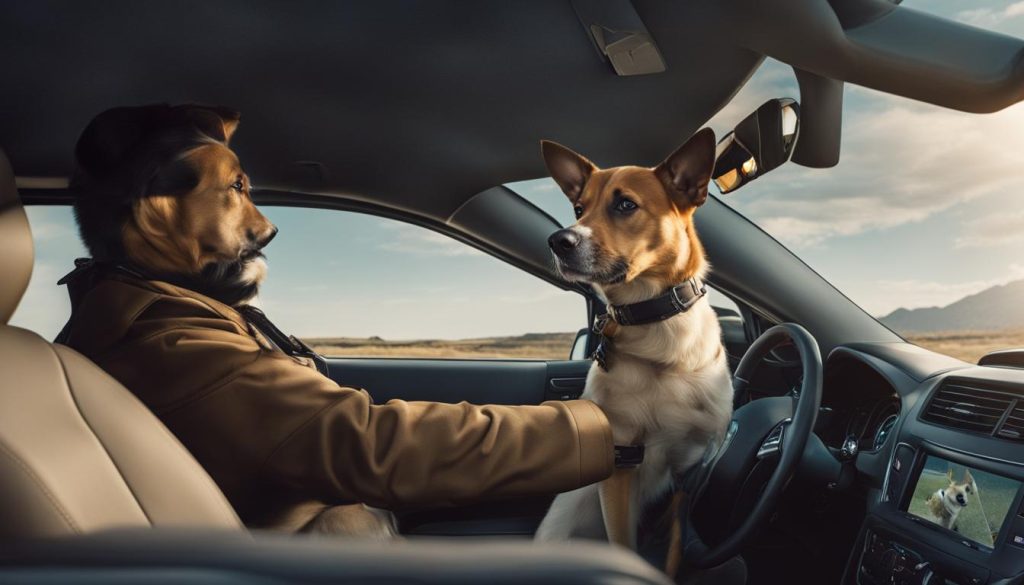
Table: Recommended Car Safety Products for Dogs
| Restraint Option | Description | Recommended Brands |
|---|---|---|
| Dog Car Harness | A harness that attaches to the car’s seatbelt system, keeping your dog secure and preventing movement within the vehicle. | Ruffwear, Kurgo, Sleepypod |
| Dog Seatbelt | A seatbelt specifically designed for dogs, attaching to their harness and preventing them from roaming around the car. | Mighty Paw, Vastar, EzyDog |
| Dog Car Seat | A specialized seat that provides comfort and elevation for smaller dogs, allowing them to look out of the window while secure. | K&H Pet Products, Snoozer, PetSafe |
| Dog Crate | A secure crate that can be fastened in the car, providing a safe and confined space for larger dogs during travel. | MidWest Homes, Petmate, AmazonBasics |
| Dog Car Barrier | A barrier that separates the back seat from the rest of the car, preventing your dog from accessing the front area and causing distractions. | Bergan, Bushwhacker, PKZ |
To put it simply, a well-prepared and secure dog is a happy and safe travel companion. Don’t compromise on their safety and make sure they are restrained and comfortable during car journeys.
Final Thoughts
Summing up, when it comes to driving with your dog, safety should always be the top priority. By following these safety tips, you can ensure a secure and comfortable journey for both you and your furry friend.
First and foremost, restraining your dog in the back seat is crucial to prevent distractions and potential hazards. Whether using a dog car harness, seatbelt, or crate, keeping your dog in one position is essential for their safety and the safety of other passengers.
Additionally, take the time to gradually introduce your dog to car rides before embarking on long trips. This will help reduce anxiety and motion sickness, ensuring a smoother experience for your pet.
Lastly, be aware of the potential hazards for dogs in cars. Avoid letting them hang out the window or ride in the front seat, as these actions can lead to serious injuries. Always prioritize the safety and well-being of your dog while driving.
FAQ
Why is it important to restrain my dog in the car?
Restraining your dog in the car helps prevent distractions and potential hazards while driving, ensuring the safety of your pet and other passengers.
How can I get my dog used to car rides?
Start with short trips and gradually increase the length to acclimate your dog to traveling in the car. This will help reduce anxiety and motion sickness.
What are the options for restraining my dog in the car?
You can use a dog car harness or seatbelt, a dog car seat for smaller breeds, or a crate or car barrier for larger dogs to keep them contained and secure.
Why should I avoid letting my dog hang out the window or ride in the front seat?
Dogs hanging out the window or riding in the front seat can be struck by debris, thrown out of the window, or injured in a collision. Keeping your dog restrained in the back seat helps avoid these hazards.
What are the safety tips for traveling by plane with my dog?
Check the specific requirements and restrictions of the airline. A health certificate issued by a veterinarian may be necessary. Ensure your dog is comfortable and secure during the flight.
Are there any specific regulations for traveling by train with my dog?
Different train companies have varying policies and documentation requirements. Check the regulations before traveling with your dog to ensure a smooth journey.
Can I bring my dog on a cruise?
Some cruise lines allow pets in cabins during ocean crossings, while others confine them to onboard kennels. I recommend that you check with the specific cruise line for their pet policies.
How can I minimize motion sickness and anxiety for my dog in the car?
Monitor your dog for signs of distress and provide proper accommodations. Take breaks during the journey and create a comfortable environment for your dog.
What are some car safety tips for driving with my dog?
Schedule plenty of stops for bathroom breaks and exercise. Avoid distractions by not feeding your dog while driving and keeping them properly restrained in the back seat. Never leave your dog unattended in the car.
What is the conclusion of the safety tips for driving with my dog?
By following these safety tips, including proper restraint, gradual introduction to car rides, and being aware of potential hazards, you can provide a secure and comfortable journey for both you and your furry friend. Try to plan ahead, pack necessary supplies, and prioritize your dog’s well-being on the road.






